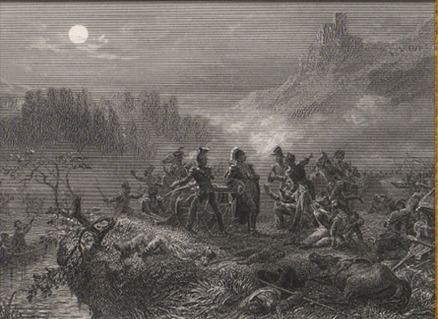initially about 6,000–8,000, expanded to 8,000-10,000 by the end of the battle Result inconclusive | Date 11 November 1805 | |
 | ||
~4,000, plus 47 officers and 895 men captured
Two Eagles, a guidon, and five guns. ~4,000 dead and wounded.
Two colors of Muskova Regiment Viatka. Combatants Russian Empire, First French Empire | ||
Battle of d renstein order of battle
The Battle of Dürenstein order of battle included a Coalition force of Russian and Austrian troops, under the overall command of Mikhail Kutuzov, and a single division of the Corps Mortier commanded by Édouard Mortier.
Contents
- Battle of d renstein order of battle
- Battle
- French Order of Battle
- First Division
- Second Division
- Third Division
- Dragoon Division
- Flotilla
- Allied Order of Battle
- First Column
- Second Column
- Third Column
- Fourth Column
- Fifth Column
- Sixth Column
- Austrian Column
- Austrian Cavalry
- References
In pursuing the Austrian retreat from Bavaria, Mortier had over-extended the three divisions of his newly formed VIII. Corps, spreading them along the north bank of the Danube. Kutuzov enticed Mortier to send Théodore Maxime Gazan's 2nd Division into a trap; French troops were caught in a valley between two Russian columns, and were only rescued by the timely arrival of the 1st Division, under command of Pierre Dupont de l'Étang. The battle extended well into the night.
Both sides claimed a victory. The French lost more than a third of the Corps, and Gazan's division experienced over 40 percent losses. The Austrians and Russians also had heavy losses—close to 16 percent—but arguably the most significant was the death in action of Johann Heinrich von Schmitt, one of Austria's most capable chiefs of staff.
Battle
Early in the morning on 11 November, three coalition columns departed from the vicinity of Krems an der Donau and Melk, circled around the promontory on which Dürnstein is located, to prepare to attack the French column that had encamped overnight at the village. In the morning, responding to rumors of a Russian rear guard, attacked the Russian encampment at nearby Stein; the two forces engaged head-on until afternoon when one of the Russian columns finally made its way through the mountain defiles and attacked the French rear. The French were trapped in the Danube canyon, attacked from the front and the rear by the Russians. A second French division, under command of Dupont, arrived and attacked the Russian column. Following this attack, another Coalition column arrived and attacked the French. The battle extended well into the night before both sides stopped.
The French lost more than a third of the VIII. Corps, and Gazan's division experienced over 40 percent losses. Mortier had failed to protect his northern flank, despite specific instructions from Napoleon. The Corps Mortier was disbanded and distributed to other Corps, but Gazan received the Officers Cross of the Legion of Honor. The Austrians and Russians also had heavy losses—close to 16 percent—but arguably the most significant was the death in action of Johann Heinrich von Schmitt, one of Austria's most capable chiefs of staff.
French Order of Battle
The French division was part of the newly created VIII. Corps, the Corps Mortier, under command of Édouard Mortier. The role of this Corps was to pursue and defeat the retreating remnants of the Austrian army on the north bank of the Danube river, and to prevent the Russian army, under command of Mikhail Kutuzov, from crossing the river and uniting his force with either the Austrians or with an approaching Russian army.
On 6 November Édouard Adolphe Mortier commanded the following forces:
First Division
Second Division
Third Division
Dragoon Division
Except for the three squadrons attached to Gazan's column, these were not involved in the fighting.
Flotilla
Total: 15 battalions, six squadrons, six guns, approximately 12,000 men, not all of which were involved in the fighting.
Allied Order of Battle
The Russian General Mikhail Kutuzov commanded the Allied Army of approximately 24,000.
First Column
Second Column
Third Column
Fourth Column
Fifth Column
Sixth Column
The Sixth Column did not take part in the fighting.
Austrian Column
Austrian Cavalry
Total: 58 battalions, 62 squadrons, 14 artillery batteries, approximately 24,000 men and 168 artillery pieces.
